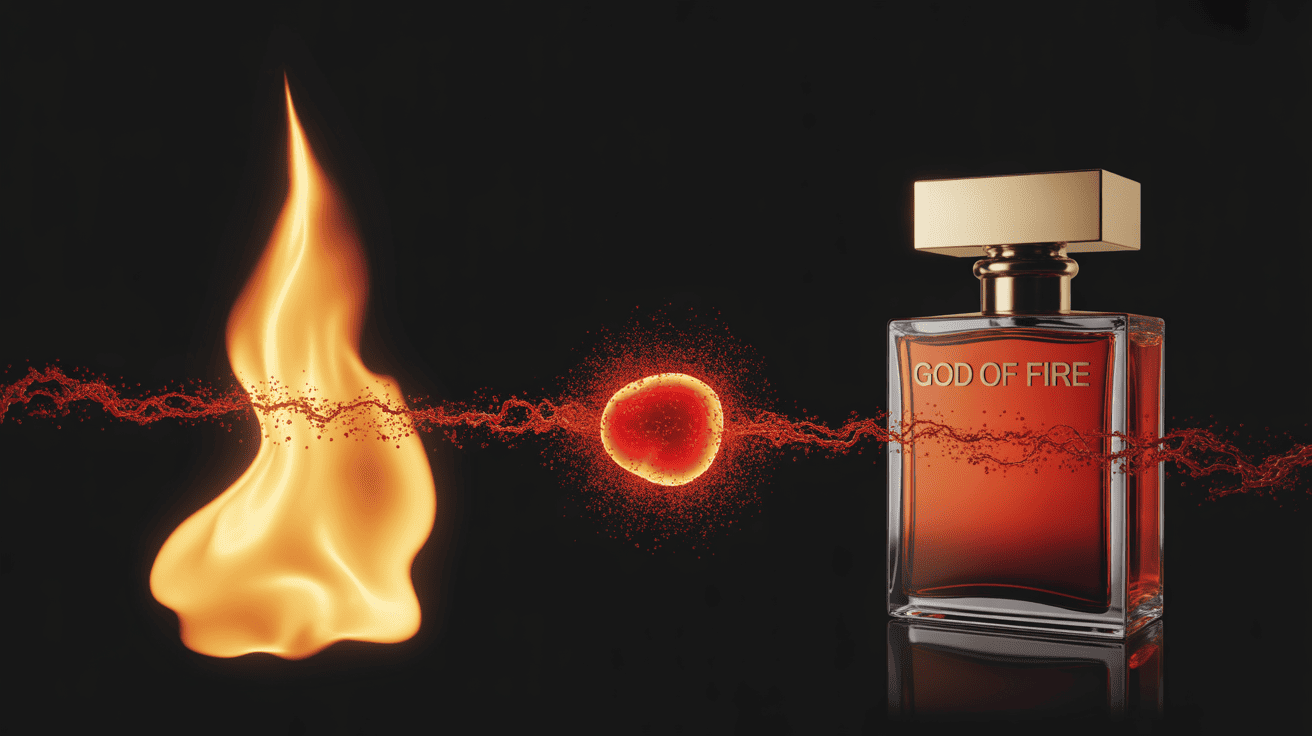When we experience the bold, exotic character of God of Fire or other “fiery” fragrances, we are engaging with a fascinating dimension of sensory perception that goes beyond traditional smell. The “heat” we feel from notes of ginger, pink pepper, or cinnamon is not an olfactory illusion or a psychological association. It is a genuine neurochemical event, a physical sensation triggered by the interaction of specific scent molecules with a temperature-sensitive protein in our nervous system called the Capsaicin Receptor, or TRPV1.
This receptor is a key player in our body’s defense system, designed to detect and respond to actual high temperatures and the chemical compounds found in things like chili peppers. When certain perfume ingredients activate this same pathway, they are essentially “tricking” our brain into feeling a sense of heat where none exists. Understanding this mechanism reveals the perfumer’s art as a form of sensory alchemy, using chemistry to create a tangible, physical feeling from an intangible scent.
This deep dive into the specific neurological response to a chemical stimulus is a powerful example of how our bodies interpret the world. It requires a precise understanding of cause and effect. A similar level of precision is needed to grasp the engineering principles that ensure the safety of a home aquarium, such as the methods used for calculating water pressure on glass, where physical forces must be accurately managed to prevent catastrophic failure.
The Body’s “Heat” Detector
TRPV1, which stands for Transient Receptor Potential Vanilloid 1, is a specialized ion channel found in the nerve endings of our skin and mucous membranes, including the lining of the nose. Its primary biological function is to act as a danger sensor. It is activated by temperatures exceeding 43°C (109°F) and by acidic conditions, sending a pain and heat signal to the brain to warn of potential tissue damage.
Crucially, this receptor is also activated by specific chemical compounds, most famously capsaicin, the molecule that gives chili peppers their fiery burn. When you eat a spicy pepper, the capsaicin binds to the TRPV1 receptors on your tongue, which then send the exact same “hot” signal to your brain as if you had touched a hot stove. This is why we perceive spiciness as a form of heat, complete with sweating and a desire for a cooling drink. The TRPV1 receptor activation is the direct cause of this physical sensation.
This same mechanism is at play when we smell certain “spicy” fragrances. Volatile molecules from ingredients like cinnamon, clove, or ginger travel into our nasal cavity and bind to these same TRPV1 receptors, triggering a mild but perceptible feeling of warmth or a tingling “buzz.”
The Perfumer’s Spice Rack
Perfumers use this neurochemical phenomenon as a secret weapon to add a unique texture and dynamism to their creations. By incorporating ingredients rich in molecules that stimulate the TRPV1 receptor, they can add a literal feeling of warmth that enhances the fragrance’s theme and makes it feel more alive on the skin. This is a deliberate artistic choice to create a multi-sensory experience.
Several common perfume ingredients are known for their ability to activate this pathway.
- Cinnamaldehyde: The primary component of cinnamon oil, it creates a distinct warming, almost burning sensation.
- Eugenol: Found in cloves, nutmeg, and bay leaf, this molecule provides a warm, spicy, and slightly numbing effect.
- Gingerol: The active compound in fresh ginger, it delivers a zesty, pungent heat that feels invigorating.
- Pink Peppercorn: While not truly “hot,” the components of this popular top note create a tingling, “electric” sensation that stimulates the same nerve pathways.
The art lies in using these ingredients in precise, micro-doses to create a pleasant, intriguing warmth without causing actual irritation or discomfort.
Feeling the Fire, Not Just Smelling It
The activation of the TRPV1 receptor by a fragrance like God of Fire or a similar spicy scent is what separates it from being merely a “warm-smelling” perfume. A vanilla or amber fragrance might evoke a psychological association with warmth and coziness, but a cinnamon or ginger-heavy scent can create an actual, physical sensation of it. This transforms the experience from a purely emotional association to a tangible, physiological event.
This is why fragrances with these notes are often described in physical terms like “tingling,” “buzzing,” “prickling,” or “vibrating.” The wearer is not just imagining these feelings; their nervous system is genuinely producing them in response to the chemical stimulus. This adds a hidden layer of complexity and realism to the perfume, making it a truly immersive experience.
This technique is a hallmark of sophisticated perfumery. It demonstrates a creator’s ability to compose not just for the olfactory bulb, which processes smell, but also for the trigeminal nerve system, which processes physical sensation. It is the art of painting a picture for two different parts of the brain with a single brushstroke.
The Psychology of Perceived Heat
The physical sensation of warmth created by TRPV1 activation has a powerful psychological effect on how we perceive a fragrance. A scent that feels warm on the skin is often interpreted as being more comforting, sensual, and enveloping. This is likely due to our deep-seated association of physical warmth with safety, comfort, and human connection.
A perfumer can leverage this to great effect. By adding a hint of a “hot” spice to a sweet floral or a rich gourmand fragrance, they can make the entire composition feel more luxurious and intimate. The sensation of physical warmth adds a subliminal layer of comfort and intimacy that enhances the wearer’s emotional connection to the scent.
This is why many “winter” or “date night” fragrances feature these spicy, trigeminal-stimulating notes. They are designed to create a literal aura of warmth around the wearer, a subtle but powerful signal of comfort and allure. It is a masterful use of neurochemistry to achieve a specific emotional and psychological outcome.
Frequently Asked Questions
While the name is certainly evocative, the “fire” can be interpreted as referring to the real, physical sensation of warmth and vibrancy that can be created by its spicy and tropical notes, which stimulate the TRPV1 receptor. The fragrance’s character is built around creating a feeling of energy and heat, which is a tangible neurological effect, not just a marketing concept.
In the very low, controlled concentrations used in fine perfumery, they are safe for most people. However, individuals with extremely sensitive skin or a specific allergy to ingredients like cinnamon could potentially experience redness or irritation. As with any new cosmetic product, a patch test is always recommended if you have known sensitivities.
Yes. The TRPM8 receptor is the counterpart to TRPV1. It is activated by physical cold and by “cooling” molecules like menthol (from mint) and eucalyptol (from eucalyptus), which is why fragrances with these notes produce a distinct physical sensation of cold or coolness.

